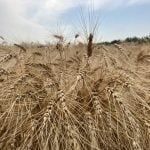Glacier FarmMedia—Bids for Canadian Western Red Spring (CWRS) and Canadian Prairie Red Spring (CPRS) wheat varieties were higher for the week ended May 16. The price rises were mainly due to stronger United States wheat futures and weather concerns at home and abroad.
After a slow start to seeding earlier this spring, planting progress accelerated on the Prairies over the past week. In Saskatchewan, spring wheat planting jumped from 12 per cent in the first week of May to 36 per cent the week after.
In Manitoba, spring wheat and barley planting was at 58 per cent as of May 12 after only being nine per cent complete the week before. However, recent rains across the Prairies may hinder further progress.
Read Also

U.S. livestock: Feeder cattle hit contract highs on tight supply
Chicago | Reuters – All Chicago Mercantile Exchange feeder cattle futures and most live cattle futures hit contract highs on…
The Canadian Grain Commission reported 493,800 tonnes of wheat exports for the week ended May 12, less than the 604,900 shipped the week before. So far in 2023-24, 17.113 million tonnes of Canadian wheat were exported compared to 15.981 million one year ago.
The first two days of the Wheat Quality Council’s hard red wheat tour of Kansas showed an average yield of 45.8 bushels per acre, a three-year high exceeding the sub-30 bu./ac. yields from last year. Fields surveyed in Oklahoma averaged a 33.68 bu./ac. yield, slightly less than expected.
Last week, three grain-producing states in Russia declared states of emergency after frosts severely damaged crops including wheat. On May 16, SovEcon cut its 2024-25 Russian wheat production estimate by 3.9 million tonnes at 85.7 million.
Canadian Western Red Spring (CWRS) wheat prices were up C$4 to C$6.90 per tonne, according to price quotes from a cross-section of delivery points compiled by PDQ (Price and Data Quotes). Average prices were between C$323.80/tonne in southeast Saskatchewan to C$341.50 in southern Alberta.
Quoted basis levels ranged from between C$59 to C$76.60/tonne above the futures when using the grain company methodology of quoting the basis as the difference between the U.S. dollar denominated futures and the Canadian dollar cash bids.
Accounting for exchange rates and adjusting Canadian prices to U.S. dollars (C$1=US$0.7342), CWRS bids were from US$237.80 to US$250.70/tonne. Currency adjusted basis levels ranged from US$14.10 to US$27.10 below the futures. If the futures were converted to Canadian dollars, basis levels would be C$10.40 to C$19.90 below the futures.
Meanwhile, Canadian Prairie Red Spring (CPRS) prices were up C$7 to C$7.60/tonne. The lowest average bid for CPRS was C$299.90 in southeast Saskatchewan, while the highest average bid was C$324 in southern Alberta.
The average prices for Canada Western Amber Durum (CWAD) were down C$8.50 to up C$0.70 per tonne with bids between C$383.50 in northwest Saskatchewan to C$400.10 in western Manitoba.
The July spring wheat contract in Minneapolis, which most CWRS contracts are based off of, was quoted at US$7.2075 per bushel on May 16 and 17 U.S. cents higher than the previous week.
The Kansas City hard red winter wheat futures, which are now traded in Chicago, are more closely linked to CPSR in Canada. The July contract was quoted at US$6.7325/bu., up 21.5 U.S. cents.
The July Chicago Board of Trade (CBOT) wheat contract gained 25.75 U.S. cents from the previous week at US$6.6325/bu.
The Canadian dollar advanced 0.38 U.S. cents to close at 73.42 cents U.S. on May 16.















